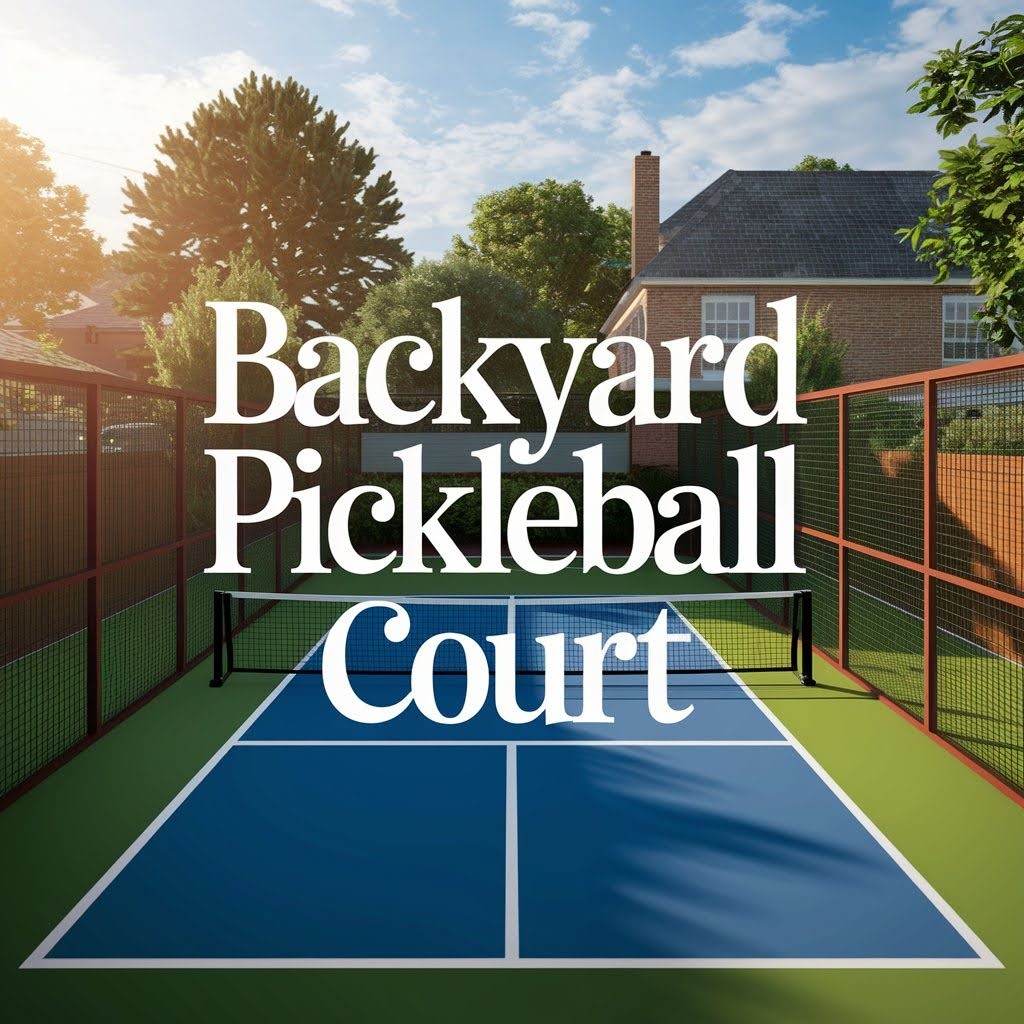Pickleball has become America’s fastest-growing sport. More families want to build courts in their backyards. But getting the size wrong can ruin your game and waste your money.
This article gives you the exact measurements you need. We’ll cover official court sizes and how to adapt them for smaller spaces. You’ll learn about net height, boundary lines, and safety zones. We also explain common mistakes that cost homeowners thousands.
I’ve helped dozens of families build backyard courts. The key is understanding which dimensions matter most and where you can make smart compromises.
By the end, you’ll know exactly how much space you need. You’ll avoid expensive errors and create a court your family will love. Whether you have a small lot or plenty of room, we’ll help you make the right choices for your budget and space.
Understanding Standard Pickleball Court Dimensions
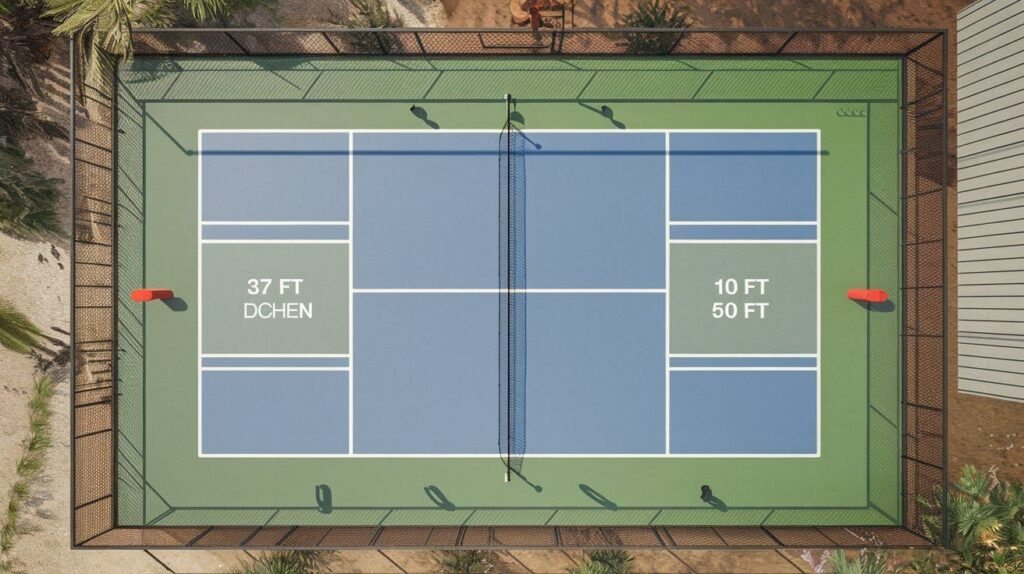
Getting the right measurements is crucial for a fun and fair game. Let’s break down the official sizes that work best.
Regulation Court Size
The playing area measures 20 feet wide by 44 feet long. This is the same size used in tournaments and clubs across the country. But you need more space than just the playing area.
Plan for a total area of 30 feet by 60 feet. This extra room gives players space to move safely. It prevents injuries from running into fences or walls during fast rallies.
These measurements come straight from the USA Pickleball Association. They’ve tested these sizes to create the best playing experience.
Key Areas of a Pickleball Court
Every court has four main sections you need to know:
Baselines sit at both ends of the court. Players serve from behind these lines. They’re 20 feet long and mark the back boundary.
Sidelines run down the long edges. Each one stretches 44 feet from baseline to baseline. Balls that land outside these lines are out of bounds.
Non-Volley Zone is the area closest to the net. Players call this the “kitchen.” It extends 7 feet back from the net on both sides. You can’t hit the ball in the air while standing here.
Service Courts are where serves must land. A centerline splits each side into two equal boxes. Each service area measures 10 feet by 15 feet.
Adjusting Dimensions for Your Backyard
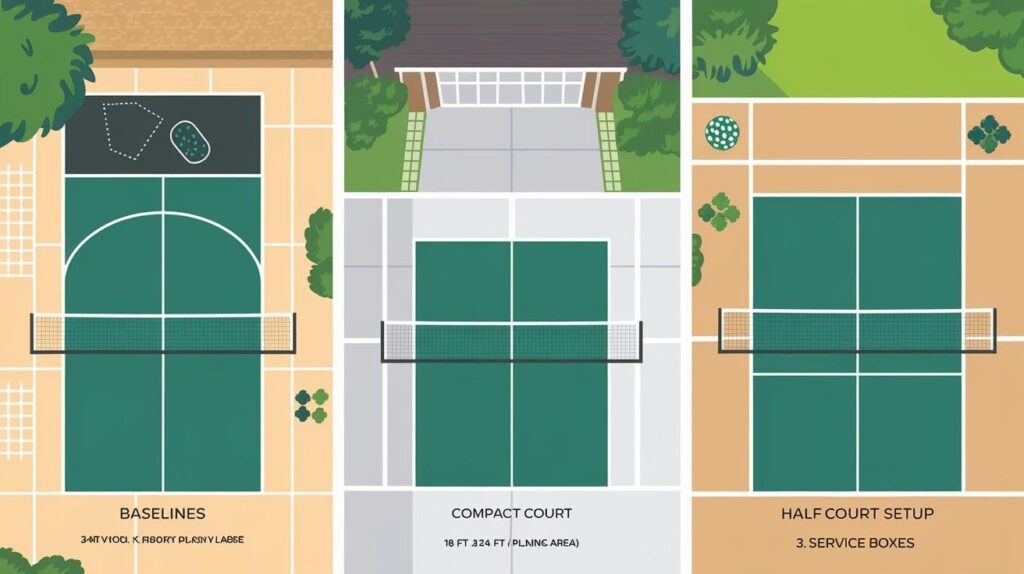
Most backyards can’t fit a full regulation court. That’s okay. You have several smart options that still give you great games.
Full-Size Court vs. Compact Options
A full court needs that 30 by 60 foot area we mentioned earlier. This includes the 20 by 44 foot playing surface plus safety space around the edges.
But smaller versions work well too. You can shrink the court by 10-20% and still have fun. A compact court might measure 18 by 36 feet for the playing area. The key is keeping the proportions similar to the original.
Focus on maintaining the right ratios between different court sections. The kitchen should still feel like 7 feet from the net. Service boxes should look balanced. This keeps the game fair and familiar.
Tips for Small Yards
Before you build anything permanent, test your layout. Use painter’s tape on concrete or chalk on grass. Mark out your proposed court and play a few games. You’ll quickly see what works and what doesn’t.
Consider a half-court setup for tight spaces. This works great for practice and skill drills. Kids especially love half-court games. You need about 20 by 22 feet for this option.
Turn existing surfaces into courts. Many driveways make excellent temporary courts. Just add some tape lines and a portable net. Basketball courts work well too. You can even share the space – pickleball during the day, basketball at night.
How to Lay Out Your Pickleball Court
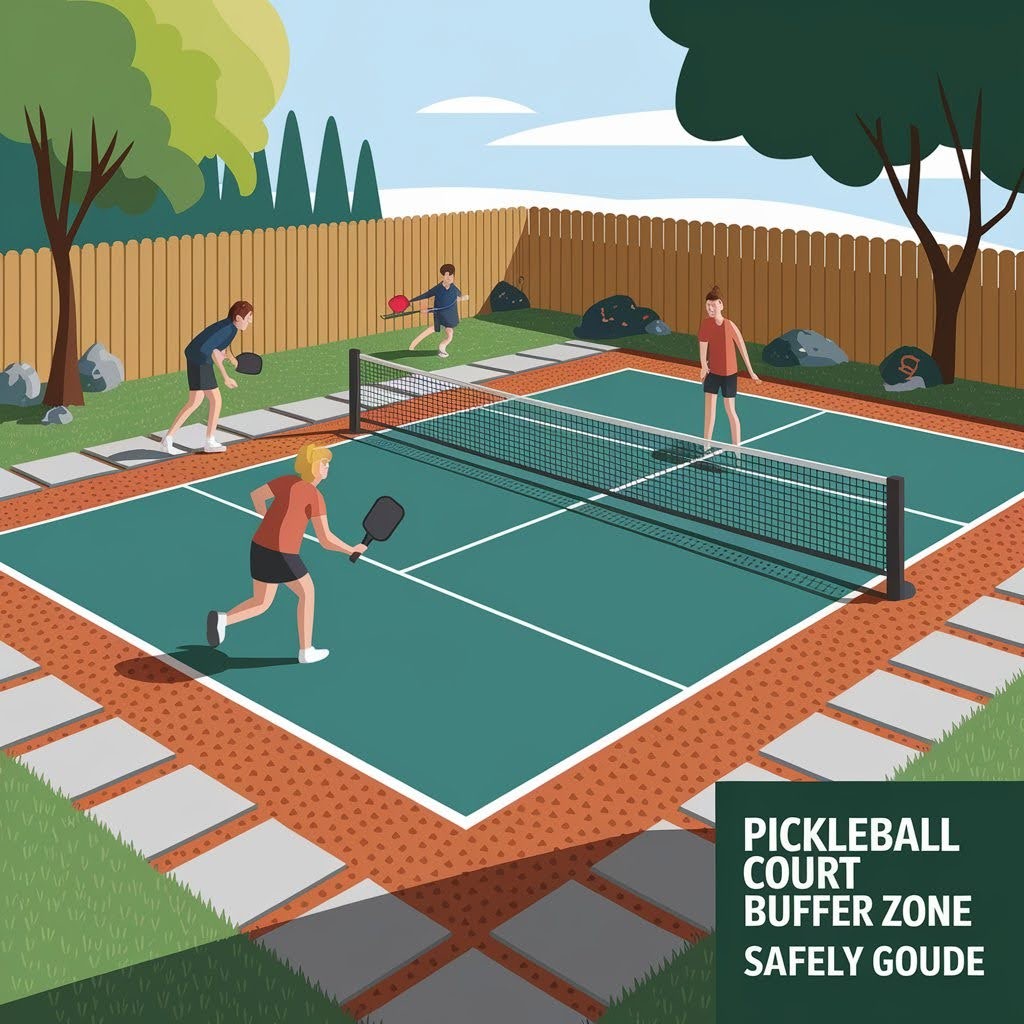
Getting your court positioned and marked correctly makes a huge difference in how well it plays. Let’s walk through the process step by step.
Orientation and Positioning
Point your court north to south if possible. This keeps the sun from shining directly into players’ eyes during most games. Morning and evening matches become much more comfortable.
Find the flattest spot in your yard. Even small bumps and dips affect ball bounce. Walk around your proposed area and look for slopes or uneven ground. A level helps you check how flat the surface really is.
Avoid low spots where water collects after rain. Your court will dry faster on slightly higher ground. Stay away from overhanging tree branches too. You need clear space above the court for high shots.
Marking and Measuring Accurately
Gather these tools before you start: a 100-foot tape measure, chalk line or string, stakes, and a level. Having everything ready saves time and reduces errors.
Start by marking your corners. Measure carefully and double-check each distance. Use the 3-4-5 rule to make perfect right angles. For a pickleball court, measure 48 feet and 4 inches across the diagonal. This confirms your rectangle is square.
Many people rush the measuring step. Take your time here. Crooked lines make the game frustrating. Uneven service boxes create unfair advantages. Mark your baselines first, then sidelines, then interior lines.
Check your measurements twice before making anything permanent. It’s much easier to move stakes than rebuild a finished court.
Optional Buffer Zones and Safety Clearances
Smart planning goes beyond just the court lines. The space around your court matters just as much for safety and enjoyment.
Why Extra Space Matters
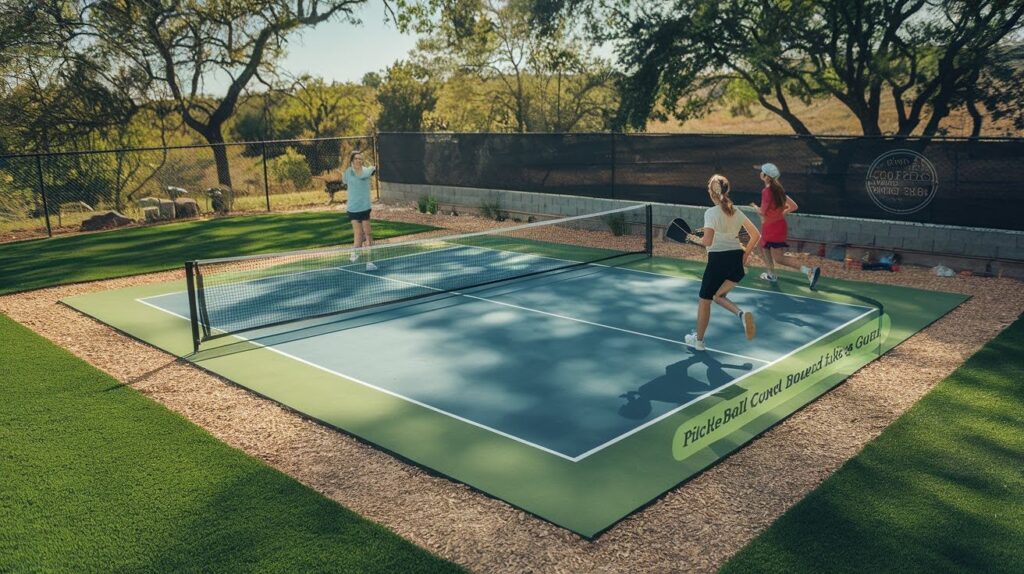
Give yourself 5 to 10 feet of clear space on all sides if you can. This buffer zone prevents painful collisions with walls, fences, or landscaping. Players often run past the court lines chasing balls.
Think about how you move during a game. You might take three or four steps after hitting a shot near the baseline. Without enough room, you’ll slam into obstacles or pull up short on good shots.
Extra space also makes games more relaxed. Players feel confident making aggressive plays when they know they won’t crash into anything. Your games become faster and more competitive.
Consider what’s around your proposed court area. Hard surfaces like concrete patios are dangerous. Soft grass or mulch work better for buffer zones. Remove any rocks, sprinkler heads, or garden tools from these areas.
Fencing and Boundaries
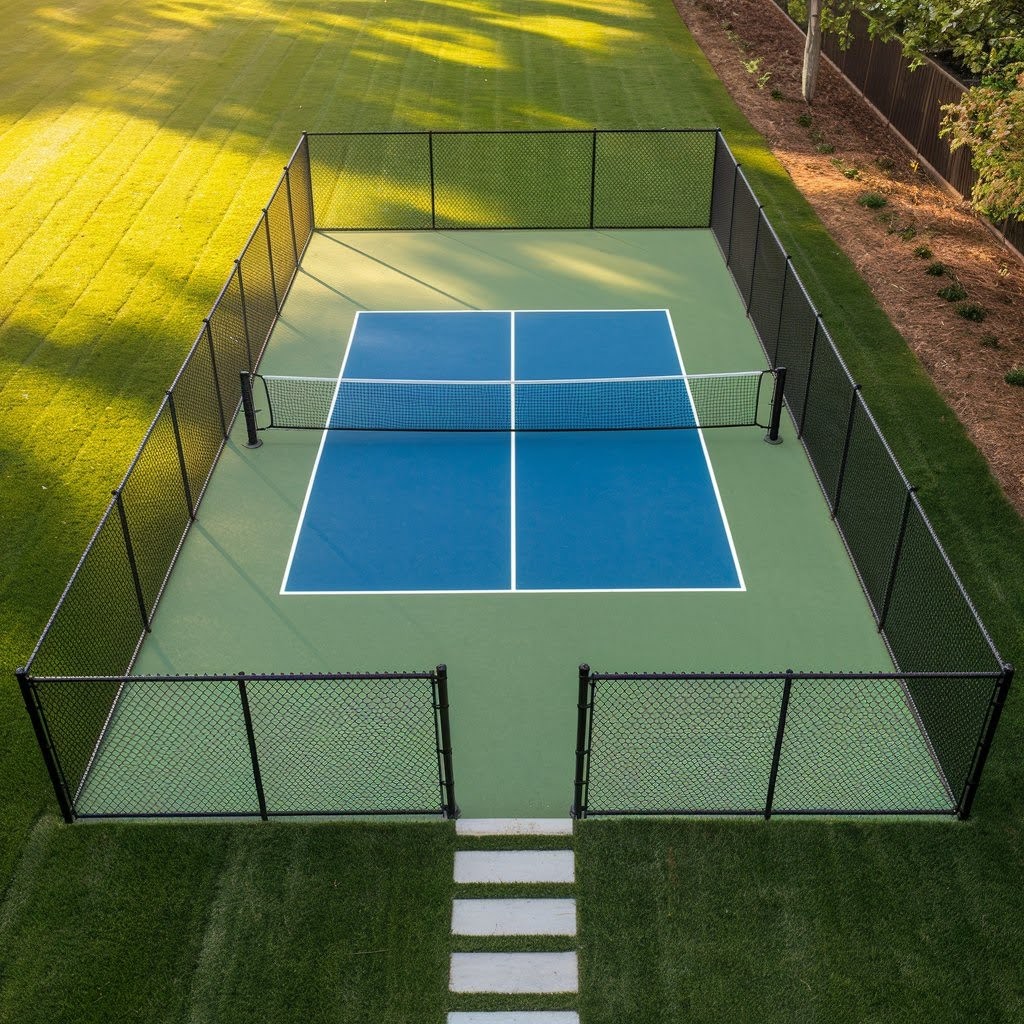
Fencing serves two main purposes: keeping balls in and marking clear boundaries. You’ll spend less time chasing balls into neighbors’ yards or flower beds.
Plan for fencing that’s at least 10 feet high behind the baselines. Balls fly fast in pickleball. Lower fences won’t stop hard shots. Side fencing can be shorter – around 6 to 8 feet works fine.
For backyard courts, consider a fence area of about 40 by 70 feet total. This gives you the court plus some buffer space inside the fenced area. The fence doesn’t need to sit right on the court lines.
Chain link works well and costs less than other options. Vinyl fencing looks nicer but costs more. Whatever you choose, make sure gate openings are wide enough for maintenance equipment.
Line Width and Paint Specifications
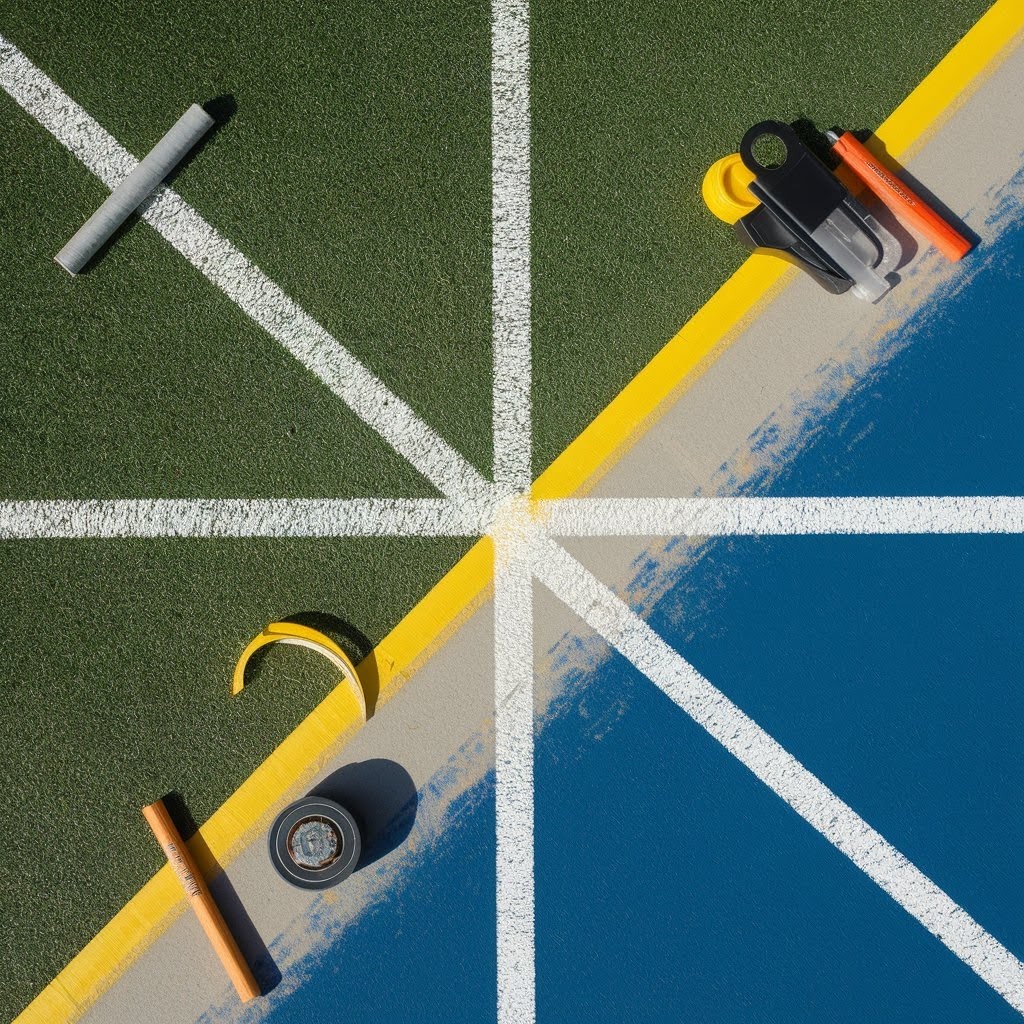
Getting your lines right affects how the game plays. The wrong width or poor marking can cause arguments during matches.
Regulation Line Width
All court lines should be exactly 2 inches wide. This includes baselines, sidelines, centerlines, and kitchen boundaries. Thinner lines are hard to see. Thicker lines change how much playing area you have.
Remember that lines count as “in” during play. When a ball touches any part of a line, it’s good. This rule makes 2-inch lines important for fair calls. Players need to see clearly where the ball lands.
Use the same width for every line on your court. Mixing different sizes looks unprofessional and confuses players. Consistent lines make your court feel official.
Marking Methods
You have several options depending on your surface and budget. Each method has pros and cons.
Chalk works great for temporary courts. It’s cheap and easy to apply. But rain washes it away quickly. Use chalk for testing layouts before making permanent lines.
Painter’s tape gives clean edges and removes easily. Choose high-quality tape that won’t leave residue. This option works well for smooth surfaces like concrete. Replace tape when it starts peeling.
Liquid chalk lasts longer than regular chalk but still fades over time. It works on most surfaces and costs very little. Apply it with a brush or squeeze bottle for best results.
For permanent lines, use court paint designed for your surface. Concrete needs different paint than asphalt. Quality paint lasts several years with proper care.
Tools and Best Practices for Clean Lines
Get a chalk line tool for straight edges. Snap lines between your marked points before painting or chalking. This prevents wobbly lines that look amateur.
Mask off areas with tape before painting. Remove the tape while paint is still slightly wet. This gives you sharp, clean edges without peeling.
Apply thin coats rather than one thick layer. Multiple thin coats last longer and look smoother. Let each coat dry completely before adding the next one.
Work in good weather conditions. Avoid painting on windy days or when rain threatens. Temperature matters too – most paints work best between 50 and 85 degrees.
Conclusion
Building a backyard pickleball court starts with understanding the basics. A regulation court measures 20 by 44 feet, but you need 30 by 60 feet total with safety space. Smaller yards can work with compact versions that maintain proper proportions.
Accurate layout makes all the difference in play quality. Take time to measure correctly and mark straight lines. Use the north-south orientation when possible and ensure your surface is level.
Don’t let a tight budget or small space stop you. Half-courts work great for practice. Temporary tape lines on driveways create instant fun. Even a scaled-down version beats no court at all.
Focus on what works for your situation. The perfect court is the one your family will actually use. Start simple and upgrade over time as your love for the game grows.
Frequently Asked Questions
What’s the minimum space needed for a backyard pickleball court?
You need at least 20 by 44 feet for just the playing surface. But plan for 30 by 60 feet total to include safety clearance around the edges.
Can I build a pickleball court on my existing driveway?
Yes, most driveways work well for temporary courts. Just add tape lines and a portable net to transform the space into a playable area.
How much does it cost to build a basic backyard court?
A simple court with painted lines costs $500-1500 for materials. Adding fencing, professional surfacing, or permanent nets increases the price significantly.
Do I need a permit to build a pickleball court in my backyard?
Check with your local building department first. Most areas allow courts without permits, but some neighborhoods have restrictions on fence height or court placement.
What’s the difference between indoor and outdoor court dimensions?
The court size stays the same at 20 by 44 feet. Outdoor courts typically need more clearance space because wind affects ball flight and player movement.

